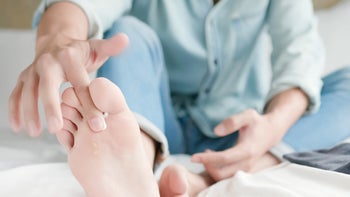
10 Terbinafine Side Effects: What to Expect When Taking This Antifungal Pill for Nail Fungus
Key takeaways:
Terbinafine is a prescription oral tablet used to treat fingernail and toenail fungus. A generic medication, it was previously sold under the brand name Lamisil.
Common terbinafine side effects include headache, gastrointestinal problems, and changes in taste or smell. And while rare, more serious side effects may include liver damage, blood disorders, or severe skin reactions.
Talk to your healthcare provider right away if terbinafine side effects are bothersome, getting worse, or not going away.
Access savings on related medications
Table of contents

Need a treatment for fingernail or toenail fungus? Your healthcare provider may have you take an oral prescription medication called terbinafine. It was previously sold under the brand-name Lamisil, but it’s not to be confused with the over-the-counter (OTC) topical product, Lamisil AT.
When you take terbinafine by mouth — instead of applying it to your skin — additional side effects are possible. Headache, changes in taste and smell, and diarrhea are a few examples. And you may need to get blood tests done ahead of time and during treatment.
Wondering what you can do to alleviate terbinafine side effects? We cover that information and more below.
Terbinafine side effects at a glance
Most of the common terbinafine side effects are mild and can be managed at home. But side effects that become bothersome, or those that are more serious, may require you to contact your healthcare provider.
Common terbinafine side effects include:
Headache
Diarrhea
Rash
Upset stomach
Abdominal pain
Changes in taste and smell
Nausea
Itching
Gas
Less common, but potentially serious terbinafine side effects include:
Depressive symptoms
Liver damage
Blood disorders
Severe skin reactions
Let’s review a little more about 10 of these terbinafine side effects and what you can do to manage them.
1. Headache
Headaches are the most common terbinafine side effect. About 1 in 8 people who took terbinafine during clinical trials reported experiencing headaches. Keep in mind that headaches can have several causes, including other medications and health conditions.
If headaches become bothersome or aren’t going away on their own, talk to your healthcare provider. They may recommend trying an OTC pain reliever, such as ibuprofen (Advil, Motrin), if it’s safe for you to take. You can also try finding headache relief with a few simple home remedies.
2. Diarrhea
Diarrhea is another common terbinafine side effect. But it’s usually mild and goes away without treatment. It’s a good idea to drink plenty of fluids to prevent dehydration, especially if your diarrhea is persistent. You can also try avoiding or limiting foods that can worsen diarrhea, including dairy and fatty foods.
Diarrhea can also be caused by other medications and health conditions. If your diarrhea continues, gets worse, or is severe, talk to your healthcare provider. If appropriate, they may suggest you try an OTC anti-diarrheal medication.
3. Rash
Terbinafine can cause rashes for some people, especially after sun exposure. This is because terbinafine can make you more sensitive to the sun, and even light from sunlamps and tanning beds. So it’s a good idea to avoid tanning beds and protect your skin when outside, such as wearing a hat and applying sunscreen when outside.
In rare cases, a rash that develops after taking a terbinafine dose might be a symptom of an allergic reaction. Other symptoms can include difficulty breathing, a fast heartbeat, and tightness of the throat. If you think you’re having a serious allergic reaction, call 911 or have someone take you to the nearest ER.
If you develop a rash after starting terbinafine, let your healthcare provider know. While also rare, some people develop a severe skin reaction. More on this later.
4. Itching
While taking terbinafine, your skin may feel itchy (also called pruritus). If your skin starts to itch, try to avoid scratching it, even though feeling itchy can be uncomfortable. You might break the surface of the skin, leading to other skin reactions or infection.
You can also take steps to reduce additional skin irritation, such as avoiding fabrics that might irritate your skin (like wool) and opting for gentle soaps and moisturizers.
As mentioned above, sometimes a rash may develop when you’re taking terbinafine. Let your healthcare provider know if this happens. Get emergency medical care if you think you might be having an allergic reaction.
5. Stomach upset
Some people taking terbinafine experience an upset stomach, otherwise known as indigestion. This can include symptoms such as nausea, gas, and stomach pain. You can take terbinafine with or without food. But if it’s upsetting your stomach, try taking your dose with a small meal or snack to see if that helps.
If you’re still experiencing indigestion, your healthcare provider may recommend an OTC product to manage your symptoms, such as bismuth subsalicylate (Pepto Bismol). Simethicone (Gas-X) may also be helpful if you’re feeling bloated from gas. Let them know if your symptoms worsen or won’t go away.
6. Abdominal pain
As mentioned above, terbinafine may cause pain in your stomach or abdomen. Mild, temporary pain may be due to indigestion. But pain that’s severe or accompanied by other symptoms can be a symptom of a more serious problem.
Abdominal pain can have several different causes. So it’s a good idea to let your healthcare provider know if it’s bothersome, not going away, or getting worse. They can help determine the cause and best next steps. But severe abdominal pain may warrant a trip to the nearest ER.
7. Changes in your sense of taste and smell
Cases of loss of taste and smell have been reported with terbinafine. In rare instances, it’s severe enough to affect your appetite or mood.
Changes in taste or smell may go away after stopping terbinafine. But, there may be some instances where they become permanent. So it’s a good idea to report any noticeable changes to your healthcare provider right away.
8. Liver damage
While rare, terbinafine has been linked to cases of liver damage in people with and without pre-existing liver problems. Because of this, your healthcare provider may check your liver health before starting terbinafine and periodically during treatment.
If your liver enzymes are elevated — a sign of inflammation or damage — you may be told to stop terbinafine. Let your healthcare provider know If you develop any signs or symptoms of liver damage. Watch for yellowing of your skin or eyes (jaundice), upper-right side abdominal pain, and dark, tea-colored urine.
9. Blood disorders
Low white blood cells, especially low neutrophils, is a rare but serious terbinafine side effect. These cells play an important role in your immune system. If this happens to you, it could increase your risk of getting an infection.
Your healthcare provider may monitor your white blood cells while taking terbinafine. If your neutrophils are too low, they may need to stop your terbinafine treatment. And if you experience any signs or symptoms of an infection, such as a fever, let them know right away.
10. Severe skin reactions
Terbinafine can rarely cause very serious skin reactions. Examples include Stevens-Johnson syndrome (SJS) and Drug Reaction with Eosinophilia and Systemic Symptoms (DRESS) syndrome.
Keep an eye out for a rash with flu-like symptoms, such as fever, muscle aches, and swollen lymph nodes. If these symptoms develop, go to the nearest ER. These skin reactions can affect your organs and become life-threatening. So it’s important to treat them right away.
When should you contact your healthcare provider about terbinafine side effects?
Talk to your healthcare provider if you experience terbinafine side effects that bother you or aren't going away. They can help determine if your symptoms are from terbinafine or another cause and how to handle them.
Certain terbinafine side effects require medical attention. These can include rare side effects such as liver damage, blood disorders, and severe skin reactions. Keep an eye out for jaundice, severe abdominal pain, or dark-colored urine. And speak with your provider if you feel like you may be getting sick or experience an usual or severe rash.
The bottom line
Common terbinafine side effects include headache, rash, and diarrhea. Upset stomach, itching, and taste changes are also possible. While rare, serious side effects can include liver damage, blood disorders, and severe skin reactions.
Let your healthcare provider know if any terbinafine side effects are bothersome, getting worse, or not going away. Flu-like symptoms followed by a rash may indicate a skin reaction that requires immediate medical attention. This is also the case for jaundice or severe abdominal pain.
Speak with your healthcare provider or pharmacist if you have questions about taking terbinafine.
Why trust our experts?



References
Breckenridge Pharmaceutical, Inc. (2023). Terbinafine hydrochloride tablet [package insert]. DailyMed.
Was this page helpful?
Related Articles
Browse medications
View AllResearch prescriptions and over-the-counter medications from A to Z, compare drug prices, and start saving.















